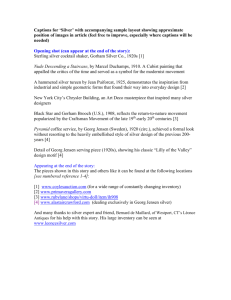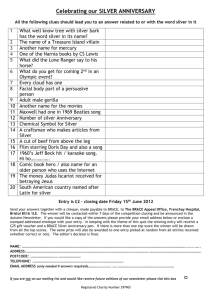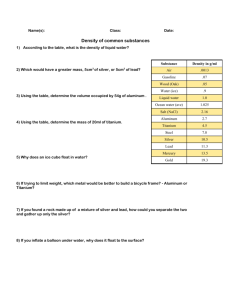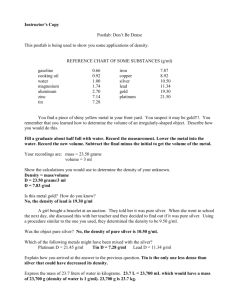DBQ Essay - Silver Trade
advertisement
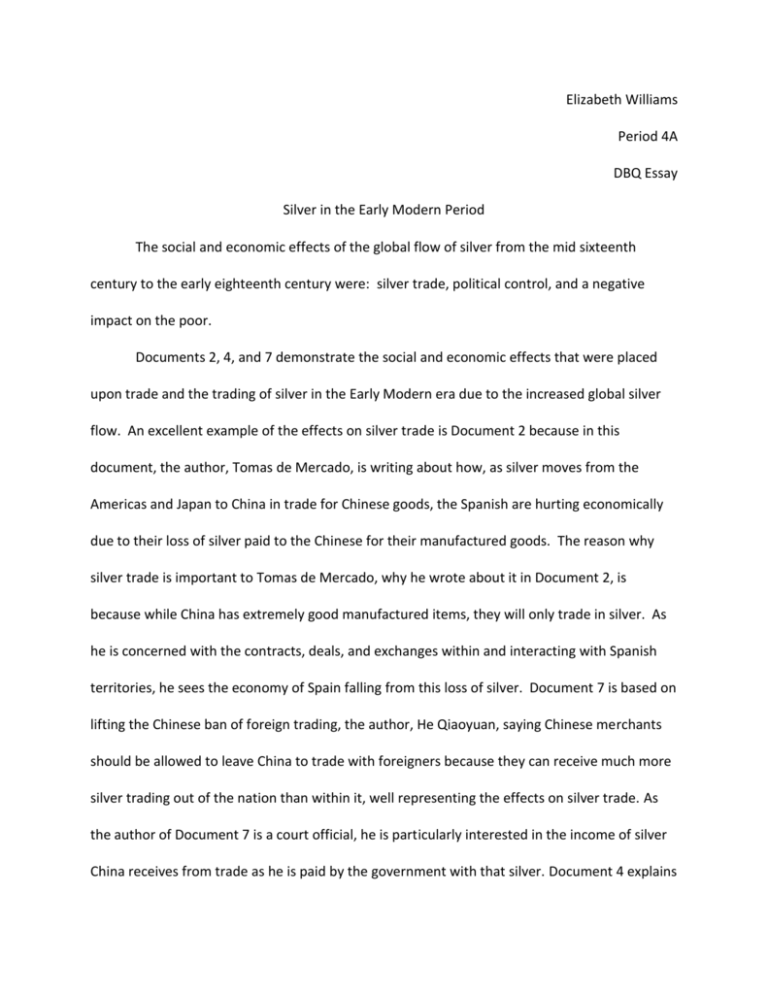
Elizabeth Williams Period 4A DBQ Essay Silver in the Early Modern Period The social and economic effects of the global flow of silver from the mid sixteenth century to the early eighteenth century were: silver trade, political control, and a negative impact on the poor. Documents 2, 4, and 7 demonstrate the social and economic effects that were placed upon trade and the trading of silver in the Early Modern era due to the increased global silver flow. An excellent example of the effects on silver trade is Document 2 because in this document, the author, Tomas de Mercado, is writing about how, as silver moves from the Americas and Japan to China in trade for Chinese goods, the Spanish are hurting economically due to their loss of silver paid to the Chinese for their manufactured goods. The reason why silver trade is important to Tomas de Mercado, why he wrote about it in Document 2, is because while China has extremely good manufactured items, they will only trade in silver. As he is concerned with the contracts, deals, and exchanges within and interacting with Spanish territories, he sees the economy of Spain falling from this loss of silver. Document 7 is based on lifting the Chinese ban of foreign trading, the author, He Qiaoyuan, saying Chinese merchants should be allowed to leave China to trade with foreigners because they can receive much more silver trading out of the nation than within it, well representing the effects on silver trade. As the author of Document 7 is a court official, he is particularly interested in the income of silver China receives from trade as he is paid by the government with that silver. Document 4 explains how the Portuguese trade with China and Japan by selling their goods to the Japanese in exchange for gargantuan amounts of silver, then taking that silver and trading for luxury items made by the Chinese. An additional document that would clarify the opinions expressed in Document 4 would be a document written by a Japanese merchant and his thoughts on isolation. This additional document would clarify Document 4 because it would either deny or confirm the trading system Document 4 establishes. It would reinforce the fact that because of Japan’s isolation from the rest of the world due to the water, it was difficult to trade externally, so the Portuguese would trade within Japan. The control of those in political power over the global silver trade during the Early Modern period is addressed in Documents 1, 4, and 8. An excellent example of the way political power reacted to the global silver trade is Document 1. In this document, the author, Ye Chunji, is writing about the massive amounts of money that are spent on weddings and is ordering the people to be frugal and lower their wedding budgets in order to save silver. Because of the focus on loyalty to the state the Chinese had, in Document 1, Ye Chunji is concerned about how much silver the citizens had to pay taxes with. He is cautioning them that if they spend all they have on extravagant weddings, they will not have money left over to pay their dues to the state, and therefore, not follow the Mandate of Heaven. Document 8 superbly expresses political interest in silver trade. The composer of Document 8, Charles D’ Avenant, is British and as being such is interested in cornering the silver trade in order to reinforce Britain’s power. He wishes for the world to acknowledge the superiority of the British, and a way to do so would for Britain to be on the top of the trade ladder, above the other leading competitors. To remind you, Document 4 is explaining how the Portuguese trade with China and Japan by selling their goods to the Japanese in exchange for gargantuan amounts of silver, then taking that silver and trading for luxury items made by the Chinese. An additional document that would clarify the opinions expressed in Document 4 would be a document written by a Portuguese merchant concerning Portugal’s trades with China and Japan, confirming what Ralph Finch, the creator of Document 4, witnessed and recorded. This additional document would elucidate Document 4 because it would either verify or deny what Ralph Finch wrote, showing how the trades between the three nations actually functioned. Documents 3, 5, and 6 demonstrate the negative impact on the poor imposed by the global flow of silver over the duration of the Early Modern time. An exceptional example of the impact on the poor is Document 3. In this document, the author is writing about the prices of grain are falling due to the fact that the people can’t afford it. Because of this, tillers are paid less, which means that less ground is planted and harvested, making a shortage of grain. The government doesn’t spend the taxes they collect on the people, but make the people pay their dues and then hoard the silver they get, causing more suffering. The reason the negative impact on the poor is important to Wang Xijue, the author of Document 3, is because with the low grain prices, the farmers are bringing in less money, which is less money they pay towards taxes, and the people drift away from the Mandate of Heaven. The basis of Document 6 is many Indians are under forced labor in the silver mines, extracting ore to mint. This grueling task includes mining out the silver, then carrying it up nearly unconquerable paths to the exit. For this, they are paid very little. The author of Document 6 is interested in writing about the world wide negative impact on the poor because he, Antonio Vazquez de Espinosa, is a priest, and as such, he is particularly interested in the equal treatment of all people because in God’s eye, all people are created equally and should be treated with that in mind. Seeing this forced labor makes the author mourn for the Indians under such a harsh punishment, and wishes for such treatment to cease. Document 5 is concerned with the payment of dying cloth – in the past they could dye several times before payment was due, and then they were able pay with livestock, food, et cetera. But now, people had to pay with the scarce silver. An additional document that would clarify the opinions expressed in Document 5 would be a document written by a Chinese peasant. This additional document would help clarify Document 5 by confirming or contradicting the availability of dying cloth the commoners had. In conclusion, the social and economic effects of the global flow of silver during the Early Modern time period were: silver trade, political control, and a worldwide negative impact on the poor.


